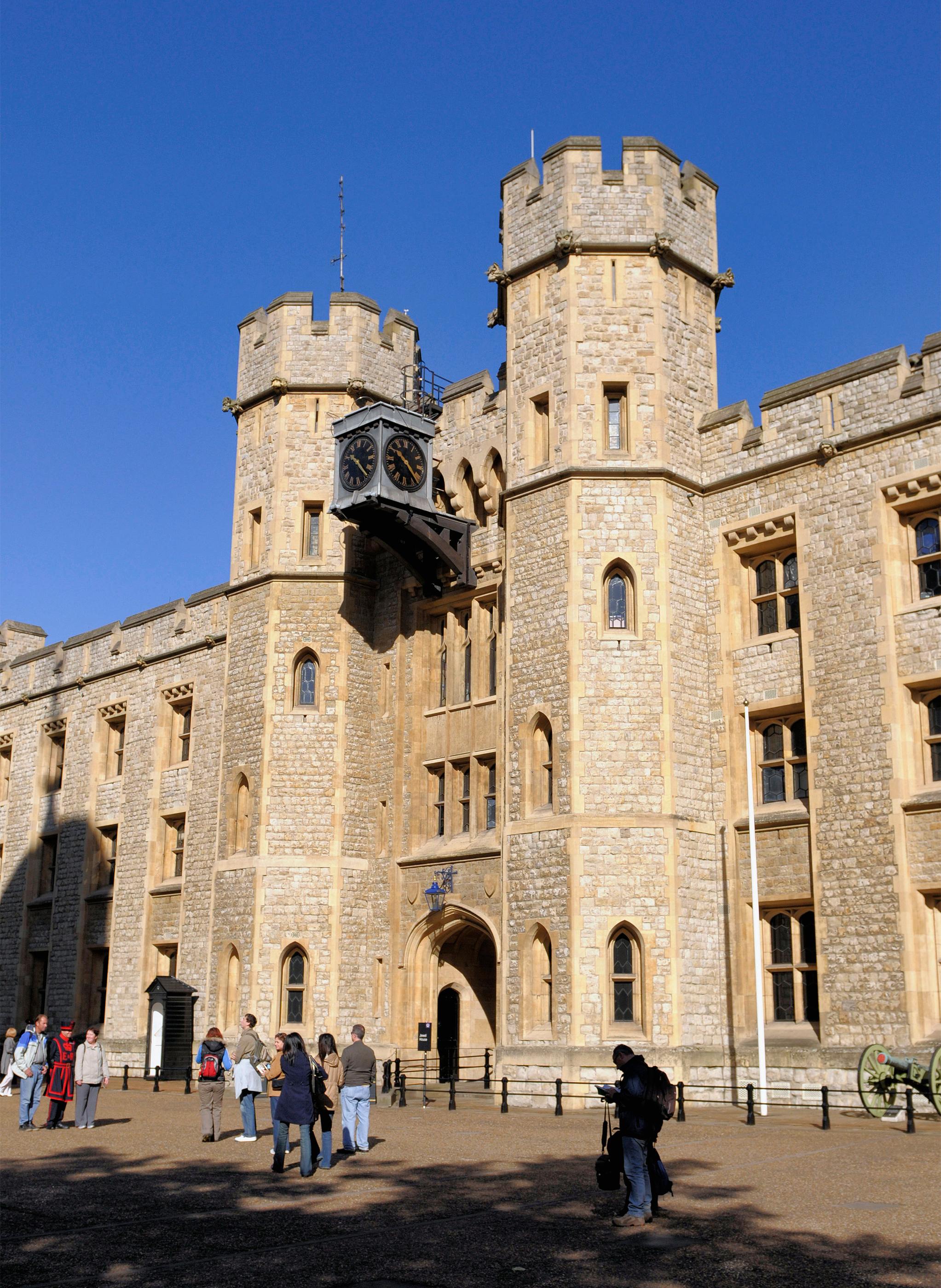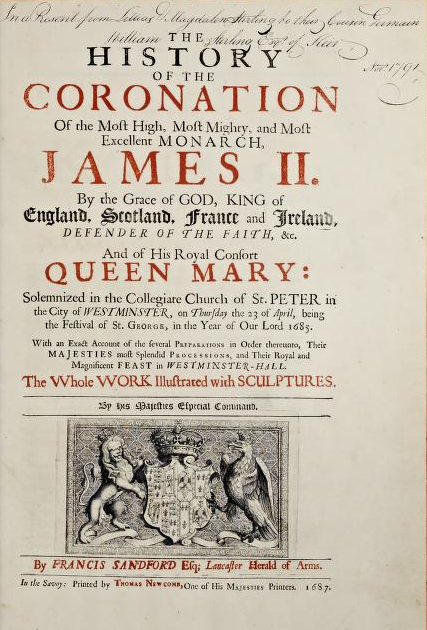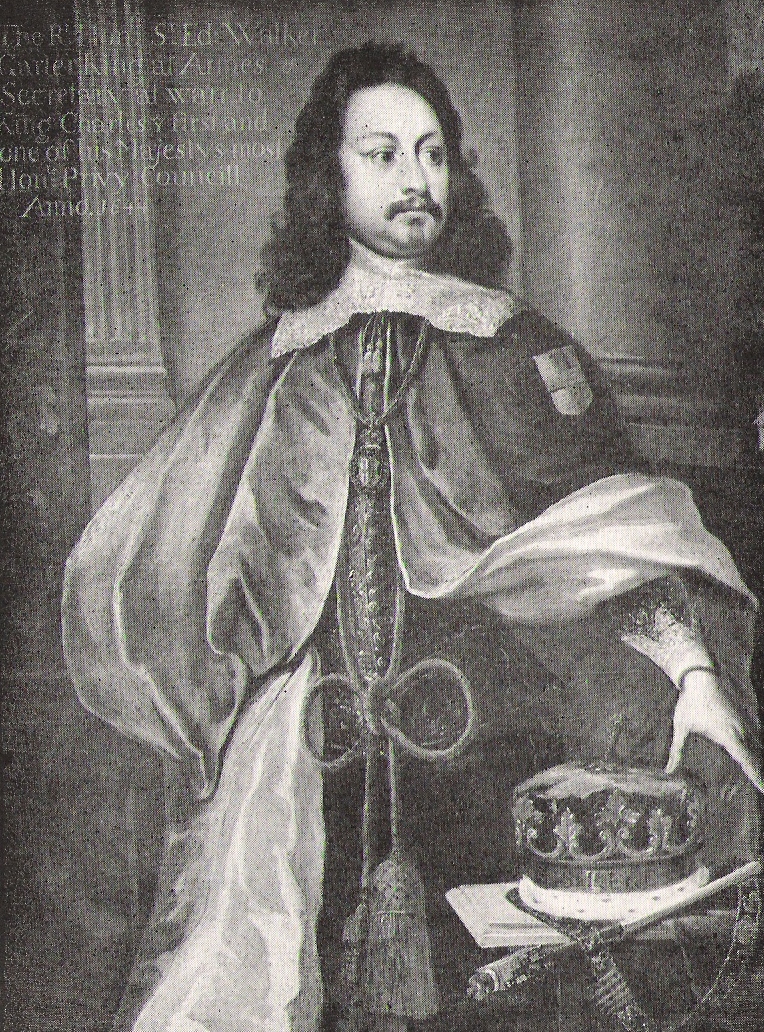|
State Crown Of Charles II
The State Crown of Charles II was a state crown created for the coronation of Charles II of England in 1661. It was created to replace the Tudor Crown destroyed in the English Civil War. It was the subject of an attempted theft by Thomas Blood in 1671, and was broken up under the reign of Queen Anne. History Following the abolition of the monarchy and the execution of Charles I in 1649, both the state crown of England (now known as the Tudor Crown) and St Edward's Crown were broken up and their valuable components sold. With the restoration of the monarchy in 1660, Charles II ordered the creation of two new imperial crowns by Sir Robert Vyner to replace those lost. On 13 May 1671, Colonel Thomas Blood made an unsuccessful attempt to steal the crown jewels from the Tower of London, flattening the state crown with a mallet in the process. Other accounts state that, in the struggle between Blood and his captor, Martin Beckman, 'the great pearl and a fair diamond fell off, and ... [...More Info...] [...Related Items...] OR: [Wikipedia] [Google] [Baidu] |
Martin Beckman
Sir Martin Beckman (1634/35–1702) was a draughtsman/painter, Swedish-English colonel, chief engineer and master gunner of England. Life Beckman was born in Stockholm, the son of Melcher Beckman and his wife Chistiana van Benningen. He left Sweden around 1645 to serve Charles I during the English Civil War. His brother, also a military engineer serving Charles, was taken prisoner by the parliament forces in 1644, but after some time on bread and water, was released in a poor state of health. In 1653 he joined the royalist exiles at Middelburg, the bearer of important information from England, and died before the Restoration. Martin Beckman in 1660 petitioned Charles II for the place of royal engineer, formerly enjoyed by his brother, and mentioned that he "was ruined and severely injured by an accident at an explosion in the preparation of fireworks to be shown on the water in the king's honour." He was accordingly employed as an engineer, and his skill in laboratory work le ... [...More Info...] [...Related Items...] OR: [Wikipedia] [Google] [Baidu] |
Crown Jewels Of The United Kingdom
The Crown Jewels of the United Kingdom, originally the Crown Jewels of England, are a collection of royal ceremonial objects kept in the Jewel House at the Tower of London, which include the coronation regalia and vestments worn by British monarchs. The coronation regalia are the only working set in Europe and the collection is the most historically complete of any royal regalia in the world. Objects used at the coronation ceremony variously denote the monarch's roles as head of state of the United Kingdom, Supreme Governor of the Church of England, and head of the British armed forces. The regalia feature heraldic devices and national emblems of England, Scotland, Wales, Northern Ireland, and other Commonwealth countries. Use of regalia by monarchs in England can be traced back to when the country was converted to Christianity in the Early Middle Ages. A permanent set of coronation regalia, once belonging to Edward the Confessor, was established after he was made a saint in ... [...More Info...] [...Related Items...] OR: [Wikipedia] [Google] [Baidu] |
William III Of England
William III (William Henry; ; 4 November 1650 – 8 March 1702), also known as William of Orange, was the sovereign Prince of Orange from birth, Stadtholder of County of Holland, Holland, County of Zeeland, Zeeland, Lordship of Utrecht, Utrecht, Guelders, and Lordship of Overijssel, Overijssel in the Dutch Republic from 1672, and List of English monarchs, King of England, Monarchy of Ireland, Ireland, and List of Scottish monarchs, Scotland from 1689 until his death in 1702. He ruled Great Britain and Ireland with his wife, Queen Mary II, and their joint reign is known as that of William and Mary. William was the only child of William II, Prince of Orange, and Mary, Princess Royal and Princess of Orange, Mary, Princess Royal, the daughter of King Charles I of England, Scotland, and Ireland. His father died a week before his birth, making William III the prince of Orange from birth. In 1677, he Cousin marriage, married his first cousin Mary, the elder daughter of his maternal u ... [...More Info...] [...Related Items...] OR: [Wikipedia] [Google] [Baidu] |
Jewel House
The Jewel House is a vault housing the British Crown Jewels of the United Kingdom, Crown Jewels in the Waterloo Block (formerly a barracks) at the Tower of London. It was opened by Queen Elizabeth II in 1994 and refurbished in 2012. Regalia have been kept in various parts of the Tower since the 14th century after a series of successful and attempted thefts at Westminster Abbey. History Pre-17th century A Keeper of the Crown Jewels was appointed in 1207. Over the subsequent centuries his title varied, from Keeper of the King's Jewels, Master of the Jewel House, Master and Treasurer of the King's Jewels and Plate, or Keeper of the Jewel House. He was also Treasurer of the Chamber, a division of the Royal Household of the monarch. In this position he was also called Keeper of the Court Wardrobe, Keeper of the Privy Wardrobe, or Receiver of the Chamber. In this capacity, he represented the Lord Treasurer's interests in the regalia, and the wardrobe and privy wardrobe. Beca ... [...More Info...] [...Related Items...] OR: [Wikipedia] [Google] [Baidu] |
Monde
A ''monde'', meaning 'world' in French, is an orb located near the top of a crown. It represents, as the name suggests, the world that the monarch rules. It is the point at which a crown's half arches meet. It is usually topped off either with a national or religious symbol, for example a cross in Christian countries. In some cases, the crossed arches might relate this object to an armillary sphere representing the cosmic orb, as seems to happen with the crown of Pedro I of Brazil or, in a different way, with the serpent in the Rainbow Portrait of Queen Elizabeth I. Gallery File:Coroa Pedro I 03.png, A ''monde'' and cross atop the crown of Pedro I of Brazil File:St Edward's Crown.jpg, St Edward's Crown (United Kingdom) File:Elizabeth_I_Rainbow_Portrait_-_crop2.jpg, Detail from the Rainbow Portrait of Queen Elizabeth I See also *Globus cruciger *Armillary sphere An armillary sphere (variations are known as spherical astrolabe, armilla, or armil) is a model of objects ... [...More Info...] [...Related Items...] OR: [Wikipedia] [Google] [Baidu] |
Francis Sandford (herald)
Francis Sandford (1630 – 17 January 1694) was an Anglo-Irish herald and genealogist. Life He was born at Carnew Castle, County Wicklow, Ireland, the third son of Francis Sandford of Sandford, Shropshire, England and his wife, Elizabeth, daughter of Chalcot Chambre of Williamscot, Oxfordshire, England.Peter Sherlock, �Sandford, Francis (1630–1694)��, ''Oxford Dictionary of National Biography'', Oxford University Press, 2004, accessed 23 July 2013. During the Irish Rebellion of 1641 Sandford escaped to Sandford in England, although afterwards he graduated BA at Trinity College, Dublin. Sandford was appointed Rouge Dragon Pursuivant in the College of Arms on 6 June 1661. In 1666, when attending King Charles II of England, Charles II at Oxford, he studied in the Bodleian Library, and he was appointed Lancaster Herald on 16 November 1676. With Gregory King, Sandford laboured two years to write a history of the coronation of James II and VII and Mary. This lavish work inclu ... [...More Info...] [...Related Items...] OR: [Wikipedia] [Google] [Baidu] |
James II Of England
James II and VII (14 October 1633 – 16 September 1701) was King of England and Monarchy of Ireland, Ireland as James II and King of Scotland as James VII from the death of his elder brother, Charles II of England, Charles II, on 6 February 1685, until he was deposed in the 1688 Glorious Revolution. The last Catholic monarch of Kingdom of England, England, Kingdom of Scotland, Scotland, and Kingdom of Ireland, Ireland, his reign is now remembered primarily for conflicts over religion. However, it also involved struggles over the principles of Absolute monarchy, absolutism and divine right of kings, with his deposition ending a century of political and civil strife by confirming the primacy of the English Parliament over the Crown. James was the second surviving son of Charles I of England and Henrietta Maria of France, and was created Duke of York at birth. He succeeded to the throne aged 51 with widespread support. The general public were reluctant to undermine the principle ... [...More Info...] [...Related Items...] OR: [Wikipedia] [Google] [Baidu] |
Lord Chamberlain
The Lord Chamberlain of the Household is the most senior officer of the Royal Households of the United Kingdom, Royal Household of the United Kingdom, supervising the departments which support and provide advice to the Monarchy of the United Kingdom, Sovereign of the United Kingdom while also acting as the main channel of communication between the Sovereign and the House of Lords. The office organises all ceremonial activity such as garden parties, state visits, royal weddings, and the State Opening of Parliament. They also oversee the Royal Mews and royal travel, as well as the ceremony around the awarding of honours. From 1737 to 1968, the Lord Chamberlain had the power to decide which Play (theatre), plays would be granted a licence for performance; this meant that he had the capacity to censor theatre at his pleasure. The Lord Chamberlain is always sworn of the Privy Council of the United Kingdom, Privy Council, is usually a peerage, peer and before 1782 the post was of Cab ... [...More Info...] [...Related Items...] OR: [Wikipedia] [Google] [Baidu] |
Garter King Of Arms
Garter Principal King of Arms (also Garter King of Arms or simply Garter) is the senior king of arms and officer of arms of the College of Arms, the heraldic authority with jurisdiction over England, Wales and Northern Ireland. The position has existed since 1415. Garter is responsible to the Earl Marshal for the running of the college. He is the principal adviser to the sovereign of the United Kingdom with respect to ceremonial and heraldry, with specific responsibility for England, Wales and Northern Ireland, and, with the exception of Canada, for Commonwealth realms of which Charles III is the sovereign. He also serves as the king of arms of the Order of the Garter and his seal and signature appear on all grants of arms made by the college. On the death of the British monarch it is Garter's duty to proclaim the new monarch. Initially, the Accession Council meets at St James's Palace in central London to declare the new monarch from the deceased monarch's line. Once the new ... [...More Info...] [...Related Items...] OR: [Wikipedia] [Google] [Baidu] |
Edward Walker (officer Of Arms)
Sir Edward Walker (1611 – February 1677) was an officer of arms and antiquarian who served as Garter King of Arms. Early life Walker was born in 1611 at Roobers in Nether Stowey, Somerset, and entered the household of the great Earl Marshal Thomas Howard, 14th Earl of Arundel, Thomas Howard in 1633. Charles I Walker was in almost constant attendance on Charles I of England, King Charles I during the English Civil War, Civil War as Clerk Extraordinary of the Privy Council, Secretary to the Council of War, Receiver General of the King's Moneys and Secretary for War. In 1635, Walker was made Blanch Lyon Pursuivant Extraordinary, in 1637 Rouge Croix Pursuivant of Arms in Ordinary, in 1638 Chester Herald of Arms in Ordinary, in 1644 Norroy King of Arms, and in 1645 Garter Principal King of Arms, so that within less than eight years of entering the College of Arms he had attained the highest post. His appointment as Garter followed shortly on his appointment as Secretary for War a ... [...More Info...] [...Related Items...] OR: [Wikipedia] [Google] [Baidu] |
House Of Hanover
The House of Hanover ( ) is a European royal house with roots tracing back to the 17th century. Its members, known as Hanoverians, ruled Hanover, Great Britain, Ireland, and the British Empire at various times during the 17th to 20th centuries. Originating as a cadet branch of the House of Welf (also "Guelf" or "Guelph") in 1635, also known then as the House of Brunswick-Lüneburg, the Hanoverians ascended to prominence with Hanover's elevation to an Electorate of the Holy Roman Empire in 1692. In 1714 George I, prince-elector of Hanover and a descendant of King James VI and I, assumed the throne of Great Britain and Ireland, marking the beginning of Hanoverian rule over the British Empire. At the end of this line, Queen Victoria's death in 1901, the throne of the United Kingdom passed to her eldest son Edward VII, a member of the House of Saxe-Coburg and Gotha, through his father Albert, Prince Consort. The last reigning members of the House of Hanover lost the Duchy ... [...More Info...] [...Related Items...] OR: [Wikipedia] [Google] [Baidu] |






